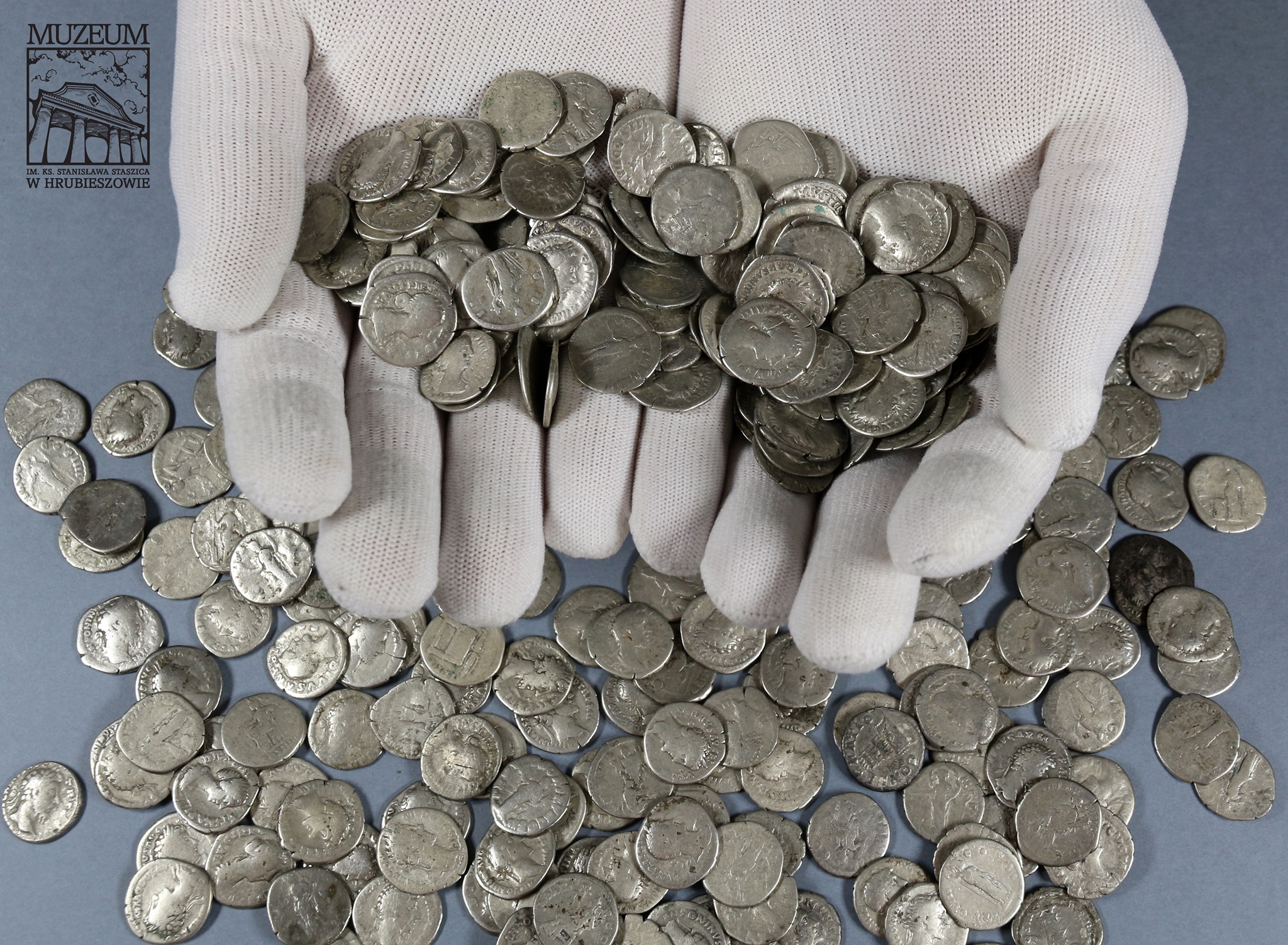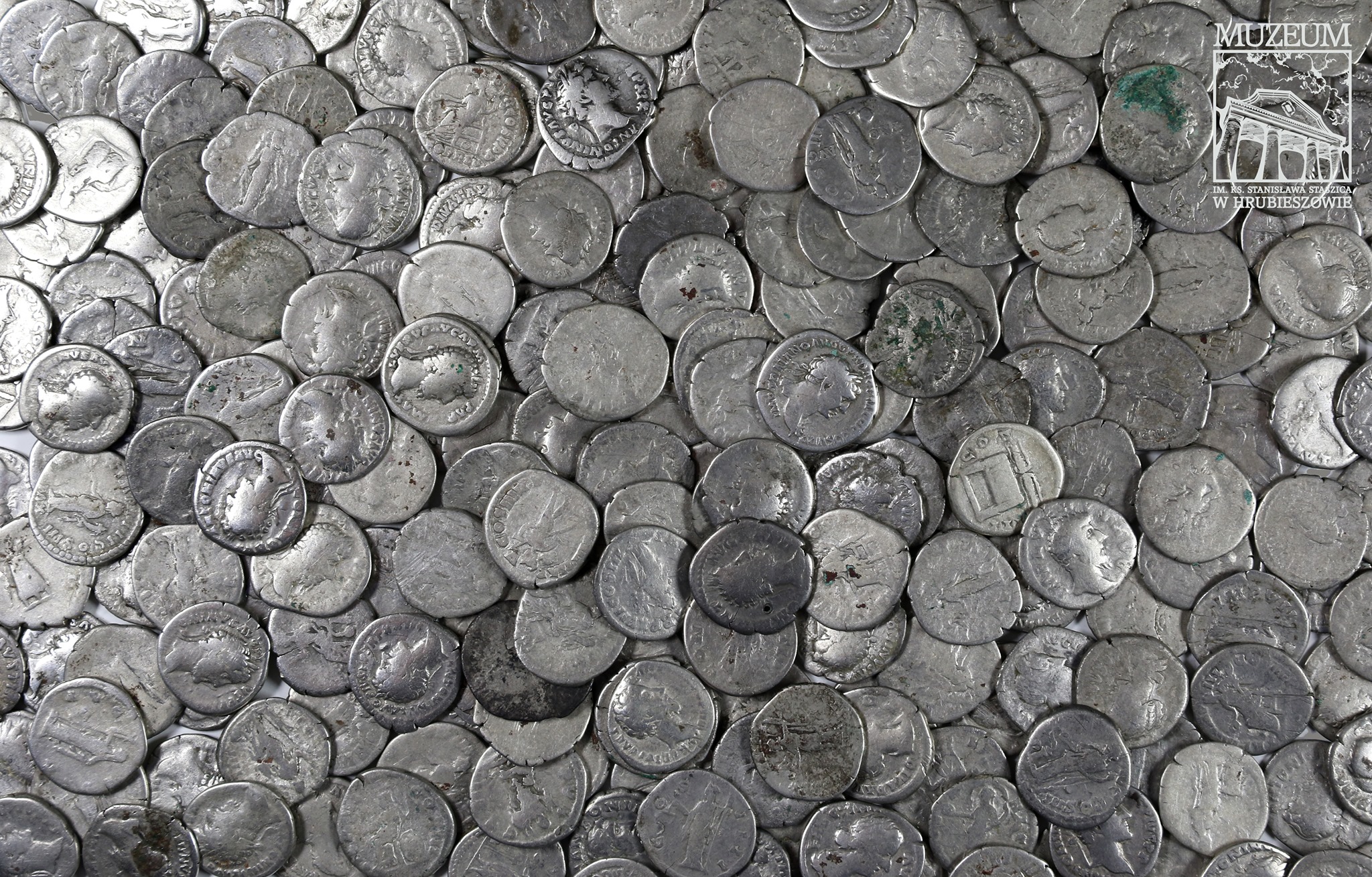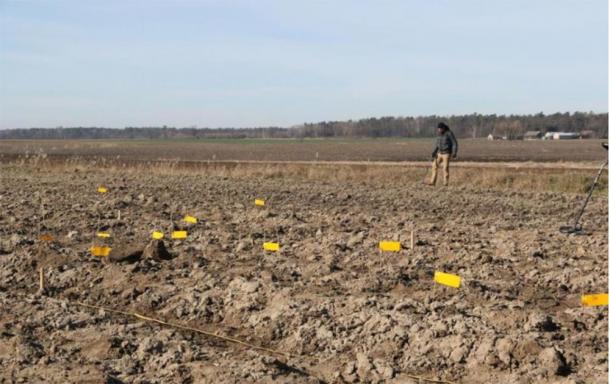Srnčí shozy jo? Teď tu o Karkulce. 😂😂😂
Man finds one of the largest Roman coin hoards in Poland while collecting scrap metal
Categories: Finds and rescue research abroad , Cleaning coins, finds , Nálezy nejenom s detektorem kovů ve východní Evropě

At the end of last year, Mariusz Dyl was looking for deer drops in a field near Cichobórz, south of Hrubieszów, when he came across ploughed-up Roman silver coins. He originally collected them and took them home.
After some time, however, he realised that such a number of Roman coins was already a really significant find that should not be left on a shelf at home and he preferred to report it to the authorities. As a result, he was able to go to the site as a volunteer helper and with the help of cooperating detectorists, under the supervision of archaeologists, found another 137 scattered coins over 100 m2.In total, the hoard contained 1,753 1st and 2nd century silver coins weighing a total of 5.5 kg.
After their surrender, the coins were taken to the museum in Hrubieszów, where they have since been cleaned and individually analysed. The director of the museum, Mr. Bartłomiej Bartecki, commented on the find: "It is undoubtedly the largest treasure from the Roman period in Lublin and one of the largest found in Poland so far. We went to the site together with a team of archaeologists and volunteers, including Mr Dyl, and together we continued the search. The coins were eventually scattered over an area of 100 square metres."
The oldest coins bear the image of the self-proclaimed Roman emperor Marcus Cocceius Nerva (reigned 96-98), while the youngest bear the image of Septimius Severus (193-211). "We can therefore assume that the coins were minted over a period of about 100 years - from the end of the 1st to the end of the 2nd century AD," Bartecki specified. According to experts, all the coins were originally placed in a wooden box or leather case. Although the natural parts of the box have long since decomposed, silver-plated bronze rivets were also discovered at the site.
In the 2nd century AD, the area of today's Lublin was inhabited by Vandals. They were later expelled by the Germanic Goths, who started the "Great Journey" from Scandinavia to south-eastern Europe at the end of the 2nd century. Many battles took place at that time. We know of numerous Vandal cemeteries from this period where warriors were buried with ritually destroyed weapons. Perhaps hoping to return to their land in the near future, the Vandals decided to bury the coins. But they miscalculated," Bartecki, the museum's director, explained the likely circumstances of the treasure's burial.
Professor Andrzej Kokowski from the Institute of Archaeology of the Marie Curie-Skłodowska University, as an expert on the Goths, added: "The situation of the Vandals' withdrawal, or rather flight from the Goths, was so bad that they hid everything of value. It seems that it was here that the Vandals lost their means to fight!" According to Bartecki, the value of the treasure at that time could correspond to about six years' salary of a Roman legionary, since a soldier earned 300 denarii a year. "It was not enough to buy a whole village, but it was not a small amount of money, especially for barbarian tribes," he added.
The coins are now owned by the museum. They are being analysed by experts from Warsaw University; conservation work should take until the end of the year. The museum plans to make the treasure public, but given the restrictions due to the Chinese virus, it will probably take the form of an online exhibition.
The museum's Facebook page states that it was only thanks to the finder's foresight that the coins were not damaged by subsequent farm work. They also praise his attitude in eventually taking the coins to the museum despite his natural desire to own them.
Roman Němec


Sources: muzeum-hrubieszow.com, scienceinpoland.pap.pl, archeology.org, ancient-origins.net
The article is included in categories:
- Archive of articles > Archaeology > Finds and rescue research abroad
- Archive of articles > Tutorials and History Hunters Magazine > Cleaning coins, finds
- Archive of articles > Archaeology > Finds and rescue research abroad > Nálezy nejenom s detektorem kovů ve východní Evropě
Post
Tak už jenom najít očima 1616 ze 1753 ks je slušný výkon 
Navíc zdroje hovoří, že byl depot rozorán v úseku dlouhém přes 100m, nikoliv na ploše 100m2
super že orbou se dostala na povrch naprostá většina mincí. A že tech pár drobných se podařilo dohledat. Nepíše se tam jestli tam byli i nějaké ty parůžky. 




Parada.


 Více než úsměvné
Více než úsměvné 
Pěkné, půjdem na parůžky, to mě nenapadlo. 
Tak na podzim borci a borkyně na shozy, jsem tedy zvědav co najdu 
Ale pozor, na ty shozy se, jak je vidět, musí na pole, a já se dosud bláhově domníval, že se dají najít hlavně v lese. Možná, že místní srnci zapichují parůžky do pole, a tak si je odlamují. Hold jiný kraj jiný mrav.



Jestli je oni tam ti srnci ty jejich shozy nechodí také rituálně pochovávat.. přesně jako Vandalové 
Nález bude vystavený kde ?
Pekná rozprávka, perfect nález.
Tie okolnosti nálezu Vám sedia? 



Podle fotky lánu přímo ukázkové typické shoziště parůžků - já bejt srnec, ani nikam jinam shazovat nechodím než doprostřed zoraného pole 
 ...
...
No já nevím jak kdo ale já na poli několik srnčích parůžků už našel , les široko daleko žádný a mince taky žádné 
Opravdu to bylo na poli kousek u hradu Bouzov. Taky sem ztoho jelen... 🦌
To mam chápat, že on sám našiel 1616 mincí očami na 100m ploche?
A potom tým archáčov s detíkmi dohladali iba 137mincí?
Dosť výrazný nepomer.
Chcel by som mať také oči. 
amateurSK máš pravdu, tak to tam píšou 
už by to chtělo vymyslet něco věrohodnějšího,díry od prasete už tu byly,venčení psa také,parůžky shodou okolností u nedávno nalezených zlatáků také ,jinak nélez neskutečný.












